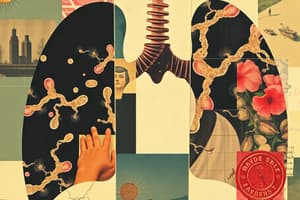Podcast
Questions and Answers
Caused by the acid-fast bacillus Mycobacterium tuberculosis
Caused by the acid-fast bacillus Mycobacterium tuberculosis
anti-tuberculars
was the first drug used in the treatment of TB disease
was the first drug used in the treatment of TB disease
streptomycin
in -, -began to see widespread use in the treatment of TB
disease and was felt to be a -
in -, -began to see widespread use in the treatment of TB disease and was felt to be a -
1952, isoniazid (INH), wonder drug
are drugs to prevent TB disease in individuals with
latent TB infection
are drugs to prevent TB disease in individuals with latent TB infection
antituberculars are divided into two categories
antituberculars are divided into two categories
those drugs chosen first, such as INH,
rifampin, pyrazinamide, and ethambutol —are considered
more effective and less toxic than drugs used in the
treatment of drug-resistant TB.
those drugs chosen first, such as INH, rifampin, pyrazinamide, and ethambutol —are considered more effective and less toxic than drugs used in the treatment of drug-resistant TB.
turns body fluids orange, and soft contact lenses may be permanently
discolored. It may also cause thrombocytopenia and GI intolerance
turns body fluids orange, and soft contact lenses may be permanently discolored. It may also cause thrombocytopenia and GI intolerance
may develop dizziness, confusion,
hallucinations, and joint pain
may develop dizziness, confusion, hallucinations, and joint pain
may lead to many adverse effects such as ototoxicity, optic nerve
toxicity, encephalopathy, angioedema, central nervous system.
may lead to many adverse effects such as ototoxicity, optic nerve toxicity, encephalopathy, angioedema, central nervous system.
may also be called mycosis, tinea, or
candidiasis
may also be called mycosis, tinea, or candidiasis
Flashcards are hidden until you start studying
Study Notes
Tuberculosis (TB)
- Caused by the acid-fast bacillus Mycobacterium tuberculosis
History of TB Treatment
- Streptomycin was the first drug used in the treatment of TB disease
- Began to see widespread use in the treatment of TB disease in the 1940s
- Felt to be a major breakthrough in the treatment of TB disease
Preventing TB Disease
- Isoniazid (INH) and other antituberculars are used to prevent TB disease in individuals with latent TB infection
Categories of Antituberculars
- Divided into two categories:
- First-line drugs: INH, rifampin, pyrazinamide, and ethambutol, considered more effective and less toxic
- Second-line drugs: used in the treatment of drug-resistant TB
Rifampin
- Turns body fluids orange
- May permanently discolore soft contact lenses
- May cause thrombocytopenia and GI intolerance
Isoniazid (INH)
- May cause dizziness, confusion, hallucinations, and joint pain
Ethambutol
- May lead to many adverse effects, including:
- Ototoxicity
- Optic nerve toxicity
- Encephalopathy
- Angioedema
- Central nervous system effects
Fungal Infections
- May also be called mycosis, tinea, or candidiasis
Studying That Suits You
Use AI to generate personalized quizzes and flashcards to suit your learning preferences.



